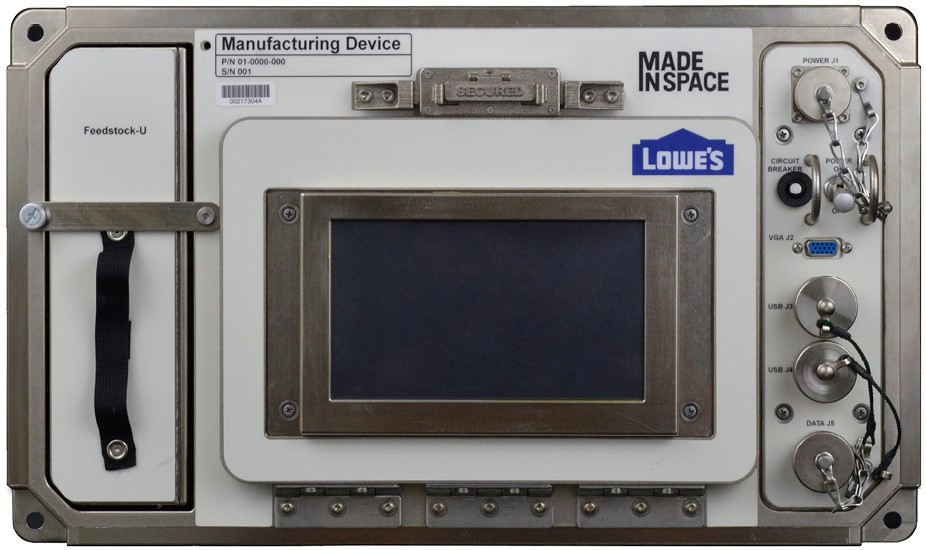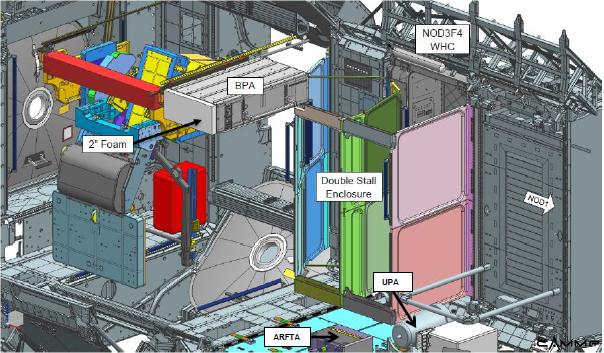Ever since Redwire’s first commercial microgravity plastic 3D printer was launched to the International Space Station (ISS) in 2016, it has provided in-orbit fabrication services and produced more than 200 tools and other parts during its time in low Earth orbit (LEO). Most recently, the Additive Manufacturing Facility (AMF) has recently manufactured a part to keep the ISS’s Brine Processor Assembly (BPA) working smoothly.
The BPA is part of the station’s water recycling system, which is why this latest additive manufacturing milestone is so important. Launched as part of Northrop Grumman’s 15th Commercial Resupply Services Mission in 2021, NASA’s BPA technology is designed to improve water recycling on the ISS, supporting one of the agency’s most critical technologies for human survival off-Earth. In the future, the BPA could increase the recycling efficiency of water needed for the Artemis generation, a new class of astronauts to help the agency return humans to the moon and reach outward to Mars.

The recently installed Brine Processor Assembly is taking water recycling aboard the International Space Station to the next level. Image courtesy of NASA’s International Space Station Research via Twitter.
On Earth, humans can consume up to 80 gallons of water each day, but once crewed missions head to space, the water they drink is recycled from their colleague’s sweat and exhaled breath – collected as condensation on the ISS’s walls. To ensure humans survive beyond Earth – where all drinkable water must be transported from home or recycled – water recovery systems are critical. There is only so much a rocket can carry, and usually, it’s expensive. For instance, launching a SpaceX rocket costs more than $4,000 per kilo. So less water launched to orbit means more room for scientific equipment. Short space missions can take enough water to survive, but as crewed missions remain for longer periods in space, the systems that provide them with drinking water need to work to perfection.
Each crew member can use roughly three gallons of water per day, and even though the station also keeps about 530 gallons of water in reserve in case of an emergency, the efficiency of the space station’s life regeneration hardware, known as the Environmental Control and Life Support System (ECLSS), is required to provide clean air and water for the station’s crews.

Brine Processor Assembly (BPA)’s dual-membrane bladder works to recover additional water from urine brine. Image courtesy of NASA/Robert Markowitz.
By reclaiming wastewater from humans, the ECLSS imitates how biological wastewater is physically filtered on Earth by granular soil and purified, as microbes in the soil break down urea, converting it to a form that plants can absorb and use to build new tissue. Wastewater also evaporates and returns as fresh rainwater, a natural form of distillation. NASA’s water purification machines on the ISS mimic these processes, though without microbes or the scale.
The ECLSS includes a water recovery system that provides clean water for astronaut use by recycling urine; condensate from crew sweat, respiration, and hygiene; and water recovered from the Air Revitalization System. Part of this system, the Urine Processor Assembly, recovers 87% of the water from urine. According to NASA, the new BPA technology that is linked to the main system uses a dual-membrane bladder to purify and recover a higher percentage of available water from urine, which will be necessary on long-duration exploration missions.
To ensure the BPA works smoothly, astronauts used Redwire’s AMF to manufacture an exhaust outlet adapter. Made from ISS individual vehicle approval (IVA)-certified materials, the 3D printed piece allows ducting to connect to a set of filters to remediate odors from the device. The use of the 3D printed adapter provided a better connection to the BPA exhaust, which allowed the BPA to continue running.
The ability to build objects in space and on-demand while avoiding launch rigors opens up entirely new opportunities for space research. In addition, as the AMF becomes increasingly relied upon, more redundant, 3D printable spares can be manufactured in orbit, leaving greater room aboard the ISS for other habitation needs and scientific research. Although most parts being produced to date are monolithic and made out of thermoplastics—such as ABS, High-density polyethylene (HDPE), and the aerospace-grade polymer polyetherimide/polycarbonate (PEI/PC)—the AMF is designed to print with other materials as they become approved for ISS operations.

Redwire’s Additive Manufacturing Facility (AMF) at the International Space Station. Image courtesy of Redwire.
Thanks to its effective build volume of 14cm x 10cm x 10cm, the AMF has already printed wrenches, handrail clamps, articulated camera mounts, buckles, cable ties, and even medical devices, to name a few. Moreover, techniques requiring repetitive use of disposables, like sample containers and valves, no longer have to be delayed indefinitely when those disposables run out, go missing or break. The AMF provides a faster, cheaper, and safer way to get hardware to space.
The full extent to which this technology could transform life in space is yet unknown, but this latest part is a great example of how 3D printing in microgravity can help improve water recovery in space. Although the AMF was built to last the remaining lifetime of the space station, Redwire is working on upcoming 3D printing projects for microgravity, including Archinaut One, which will demonstrate the in-space manufacture and assembly of solar arrays in 2022.
Subscribe to Our Email Newsletter
Stay up-to-date on all the latest news from the 3D printing industry and receive information and offers from third party vendors.
Print Services
Upload your 3D Models and get them printed quickly and efficiently.
You May Also Like
Reinventing Reindustrialization: Why NAVWAR Project Manager Spencer Koroly Invented a Made-in-America 3D Printer
It has become virtually impossible to regularly follow additive manufacturing (AM) industry news and not stumble across the term “defense industrial base” (DIB), a concept encompassing all the many diverse...
Inside The Barnes Global Advisors’ Vision for a Stronger AM Ecosystem
As additive manufacturing (AM) continues to revolutionize the industrial landscape, Pittsburgh-based consultancy The Barnes Global Advisors (TBGA) is helping shape what that future looks like. As the largest independent AM...
Ruggedized: How USMC Innovation Officer Matt Pine Navigates 3D Printing in the Military
Disclaimer: Matt Pine’s views are not the views of the Department of Defense nor the U.S. Marine Corps Throughout this decade thus far, the military’s adoption of additive manufacturing (AM)...
U.S. Congress Calls Out 3D Printing in Proposal for Commercial Reserve Manufacturing Network
Last week, the U.S. House of Representatives’ Appropriations Committee moved the FY 2026 defense bill forward to the House floor. Included in the legislation is a $131 million proposal for...


































